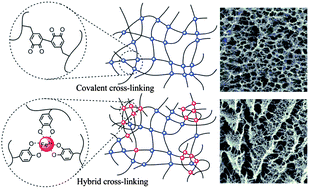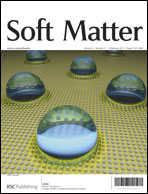Structural effects of catechol-containing polystyrene gels based on a dual cross-linking approach†
Abstract
Based on efforts to develop synthetic materials with novel properties similar to the ingenious mussel adhesive, we present a structural study of gels with different cross-linking approaches, using a catechol-bearing polystyrene system. Prior studies have shown that catechol affords a dual cross-linking system based on Fe3+–catechol complexes and oxidative coupling. In this study, the structures of gels with different cross-linking ratios were investigated by field-emission scanning electron microscopy (FE-SEM), small angle X-ray scattering (SAXS), Raman spectroscopy, and dynamic viscoelastic measurements. These results revealed that Fe3+–catechol cross-linking leads to a more compact structure, which increased the gel rigidity. In addition, Fe3+–catechol cross-links could be removed from the hybrid cross-linking system by an acidifying process, yielding a catechol–catechol cross-linked gel with stable covalent bonds. A structure in which a continuous network of loosely folded poly(styrene-co-DOPMAm) chains is combined, with a cross-linking density varying from high (coordinative) to low (covalent), was achieved by balancing both oxidation and coordination. The work presented here will provide inspiration for those designing new classes of synthetic materials with advanced properties, biomimicking extensible byssal threads.


 Please wait while we load your content...
Please wait while we load your content...